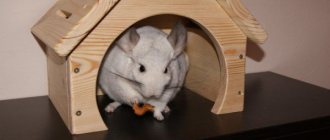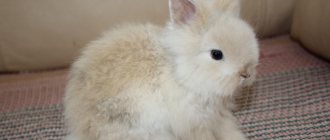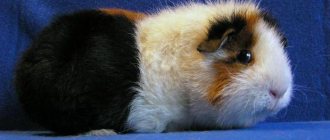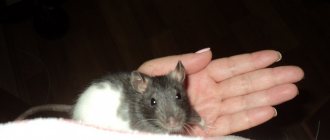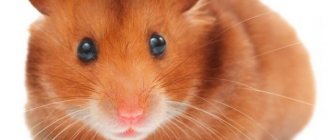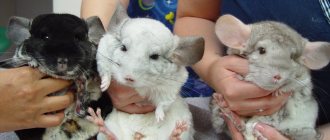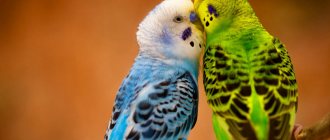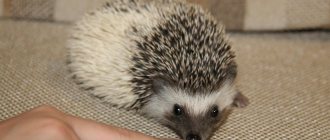To understand the habits of chinchillas, you need to go back to the basics. Chinchillas are not entirely nocturnal animals; their peak activity occurs in the evening. It is then that they require maximum attention, which is manifested in games, bathing, feeding with natural or granulated food, communication with their owners and relatives, and courtship (not only during the mating season). But if the owner is nocturnal, rodents are able to adopt this habit.
The behavior of rodents is easily explained, since most of the actions performed by chinchillas are in one way or another related to stress, including mating games. If, during boarding, they begin to scream, swear, and run around the entire cage, leaving strings of scraps of fur behind them - this is quite natural and there is no need to interfere. Although, it’s worth being nearby at such moments, because things can go too far, because when teeth come into play, everything can end in disaster.
There are several basic signs among chinchillas that help owners understand their pets:
- sounds: rumbling, quacks, screams;
- gestures accompanying sounds;
- change in behavior, from quiet to loud and back;
- fur pulling;
- splashing urine and increasing odor.
Chinchillas as pets
Fluffy and kind - the chinchilla will become an excellent family pet
In order to make an objective decision as to whether it is worth getting such a pet or not, you should first become familiar with the positive and negative aspects of having a chinchilla in the apartment.
So, the advantages of the content include the following aspects:
- chinchillas have a good-natured character and rarely bite;
- they get used to being handled without any problems;
- There will be no difficulties with training, since chinchillas respond well to it;
- their life period is quite long and reaches 20 years;
- they have an attractive appearance;
- the animals are unpretentious in maintenance and nutrition;
- do not create an unpleasant odor.
Disadvantages of keeping chinchillas:
- Pets are most active at night. They run and jump, which creates noise and can interfere with sleep;
- When moving freely around the apartment, the animals will not miss the opportunity to chew furniture, shoes, wires and anything that attracts their attention. It will not be possible to wean them from this habit;
- if you accidentally leave the cage doors open, you will have to put in a lot of effort and time to find the chinchilla;
- the animals take sand baths every day, resulting in constant dust formation in the apartment;
- a lot of space is required to place the cage;
- in the room where the chinchilla is located, it is necessary to maintain a stable temperature regime and also avoid increasing humidity;
- If an animal gets sick, finding a veterinarian who specializes in this animal is quite problematic.
Chinchillas love human company
If you have weighed all the advantages and disadvantages of owning a chinchilla and decided to purchase one, the next step is to choose a buddy. To avoid mistakes you need to learn some rules:
- The animal needs to be examined. A healthy chinchilla's fur is smooth, fits tightly to the body, does not tangle, and its eyes shine.
- You should also listen to your breathing - whistling sounds and wheezing should alert you.
- Next, you need to pick up the animal and feel its muscles. If his ribs protrude, there are areas on his body that are not covered with fur, or there is excessive accumulation of fat, then this indicates the presence of a disease or poor care.
- Eyes are an indicator of health. There should be no purulent discharge in them. Particularly dangerous is damage to both eyes. If only one is inflamed, this may simply indicate dust has gotten into it. The disease of two visual organs at once occurs due to exposure to infection.
- There is no doubt about the presence of infection if there is discharge from the nose and sneezing.
- Pet the animal against the direction of hair growth. This will allow you to detect foci of inflammation on the skin, dried pus, ticks or fleas. The presence of parasites can be determined by small black particles, which are products of the decay of their vital activity.
- If matted fur is observed in the area of the animal's anus, this indicates diarrhea, which is a consequence of improper feeding or an infectious disease.
- When purchasing a chinchilla, you should also consider the purpose for which you are getting it. If you plan to get offspring in the future, you need to immediately buy a couple of animals. If there is no such need, you can purchase one animal. But it should be remembered that in their natural environment, chinchillas live in families, so they need to communicate with other animals.
These animals do not feel comfortable alone, and the owner needs to pay more attention to them.
The selection criteria also include the financial capabilities of potential owners. The price is determined by the color of the animal and age. Chinchillas, which have a common gray color, are more expensive than colored animals.
Gnawing fur
In some photos of chinchillas you can see small glimpses in the fur. Gnawing of fur can be caused by games or fights between individuals. If an animal chews out its own fur, it means it has parasites that are bothering it.
In their natural habitat, individuals help each other cope with this disease, and the fur grows back after some time. At least 40 hairs grow from 1 bulb, forming a strong protection.
Content Features
A chinchilla will feel quite comfortable in an apartment if you provide it with the necessary living conditions. Let's take a closer look at the features of keeping a furry animal in an apartment.
The necessary conditions
The cage should be comfortable for the animal
Before a furry pet appears in your apartment, you need to prepare a home for it. This could be a cage or enclosure that suits the chinchilla's needs. She prefers well-ventilated, bright, dry and warm rooms. The cage can be purchased ready-made or made independently. But some nuances should be taken into account:
- If you intend to produce offspring, you should not choose a high cage. Small animals will climb the walls of the enclosure, and they may fall and be injured.
- For several chinchillas you will need a spacious cage - at least 70x90 cm and 50 cm in height.
- A house measuring 50x70 cm is suitable for one animal.
- It is recommended to purchase cages with a pull-out tray into which shavings or sawdust are poured. They will serve as bedding for the chinchilla.
- You can install wooden shelves up to 15 cm wide, tunnels and ladders where the animals will rest and hide.
- To raise their young and relax, chinchillas need a house that fits in a cage. It should be taken into account that the bedding will also have to be changed periodically.
- It is necessary to arrange twilight in the house so that the animals can feel themselves in natural conditions. Its length should be 30 cm, height – 15 cm.
- It is advisable to place the drinking bowl and feeder on the door or front wall. It is not recommended to place them on the floor, as the animal can turn them over or use them as a toilet.
- A ceramic or metal feeder designed for parrots, which has a special mount, is suitable. Chinchilla drinking bowls can be found in any specialty store. They are bottles equipped with a metal rod 5-6 cm long.
- One of the components of this animal’s diet is hay, which requires a separate feeder. It is fixed to the roof of the cage or installed inside. Hay that has fallen from the feeder onto the floor should be removed.
- The chinchilla belongs to the order of rodents, so one of its basic instincts is the constant need to chew something. To do this, stone or wooden objects are placed in the cage.
- The humidity level in the room where the cages are located should be 50%-70%, and the temperature should be 18°C-20°C.
How to toilet train
Toilet training is an important stage in raising chinchillas.
First you need to trace the area in the cage where the animal goes to the toilet, then pour sand or sawdust there. If the animal uses this place again for its needs, you can place a container with filler on it. First you need to check whether the animal goes into the tray. If the chinchilla does not use the prepared container as a toilet, wet sawdust is poured there. Then the animal will understand what is being sought from him.
But chinchillas can go to the litter box not only for minor needs; these animals do not control the process of defecation. Therefore, sawdust in the cage must be systematically removed. Once a week will be enough. The tray is also changed at the same frequency.
Air humidity
As mentioned earlier, chinchillas live in mountainous areas where the humidity is quite low. From this it is worth drawing a simple conclusion: high indicators will not benefit them, which is why the maximum, but already unfavorable, threshold is 75%.
If the percentage exceeds 70% for a long time, then conditions will be created on the rodent’s body for the formation of various types of fungi, which will subsequently lead to an unpleasant disease - lichen. Within 50–60%, pets will live comfortably, but with lower values it is even better, since the microclimate of the room will be closer to real ones.
Did you know? The name "chinchilla" comes from the name of one of the Peruvian provinces
—
Chincha.
Features of care
Chinchillas have long been tamed and feel comfortable in human society. They have a developed desire for socialization, so caring for their pet is more likely to become one of the pleasant worries than a duty.
Chinchilla diet
A balanced diet is the key to healthy chinchillas
These animals eat hay, special feed, nuts, barberries, rose hips, and dry bread crusts. They love fruits: plums and apples, and will not refuse raisins or dried apricots. When purchasing food, you need to make sure that the expiration date has not expired, and also study its composition. Hay ensures the normal functioning of the animal’s intestines. In summer, the diet can be diversified with a small amount of hazel, nettle, birch and apple tree branches.
Food is placed in the feeder once a day in the evening between 17.00 and 21.00. The chinchilla also consumes chalk, replenishing the content of mineral elements in its body. You should limit the amount of high-calorie foods, the consumption of which causes obesity. This negatively affects the reproductive ability of chinchillas.
Chinchillas must have constant access to water.
Bathing
Chinchillas can only swim in sand
To maintain their fur in proper condition, the animals take sand baths. For such a procedure, they need a special container - a bathing suit. This is a plastic or tin container measuring 20x20x30 cm. The bathing suit is placed in the cage twice a week for 30 minutes. It is not recommended to leave the container for a longer period, as the chinchilla may mistake it for a toilet, and the sand will need to be thrown away.
In addition, frequent sand baths dry out the animal's skin. A chinchilla bathing is quite a funny sight. If possible, a transparent container should be used to allow the procedure to be observed. You can make the container yourself from a three-liter jar or pan.
Water should not be used to bathe chinchillas.
The fur of these animals is highly dense, so it takes a long time to dry. Animals should not come into contact with liquid, as this can lead to their death.
Video: the process of bathing a chinchilla in the sand
Gastrointestinal disease
In captivity, such a disease practically does not occur, because the animals get their own food. They plan their diet carefully, eating a variety of grasses and grains and getting all the vitamins and minerals they need. In an artificial environment, the disease can develop due to poor nutrition.
Training a chinchilla at home
To make your pet happy with its behavior, it is necessary to conduct special training sessions. This is perhaps the most enjoyable part of keeping a chinchilla. Let's look at the main points to remember.
How to accustom to hands
A little patience and your chinchilla will become tame and affectionate.
To successfully establish contact with a chinchilla, you should remember that this is a shy animal. There is no need to pick up an animal on the first day of its stay in your home. Actively forcing friendship will scare him away. Initially, you need to wait a few days, during which the chinchilla will adapt to the new place. Then you can start dating:
- You should talk to the animal using a gentle intonation and repeat its name.
- A piece of raisin will help you earn his trust, as chinchillas love them very much. But it is important to observe moderation. For one time, half a raisin will be enough; you can give 1-2 pieces per day. In larger quantities, this delicacy will disrupt the animal’s digestion process.
- The highlight of the first days is offered through the cage. In this case, sudden movements should be avoided. Then you can open the door and give your pet a treat by sticking your hand into the cage. If the animal boldly takes the treat, you can move on to the next stage.
- The chinchilla can be picked up. Stroking the chin and behind the ears will help you earn trust.
- After a certain time, she will try to explore the hand, maybe approach the shoulder or face.
It is worth remembering that acquaintance will not happen in one day. This may take several months.
How to train yourself to sleep at night
The chinchilla is nocturnal. But if desired, its mode can be adjusted. This process can be started no earlier than the animal gets used to its new habitat. All necessary actions include feeding no later than 19 hours. Over time, the chinchilla will be awake during the day and use the night to sleep.
Diseases: how dangerous they are and how to treat them
Chinchillas have a strong immune system, but poor care can lead to illness.
These animals have strong immunity, which is why, with proper care, they rarely get sick. But being in unfavorable conditions can negatively affect their well-being. If the animal experiences a loss of appetite and decreased activity, this is a cause for concern. The following diseases are typical for chinchillas:
- Bronchopneumonia is accompanied by fever, difficulty breathing, nasal discharge, cough and wheezing. The animal is treated with glucose and vitamins. And also small doses of penicillin. This drug is prescribed intramuscularly once every three days. The dosage must be agreed with your veterinarian.
- Rectal prolapse. This causes constipation. The fallen part is first treated with furatsilin solution, then with paraffin oil and, using a pipette, carefully set.
- Formation of hair rings around the male genitals. This prevents it from reproducing. The rings are removed by hand. If they are dry, they are treated with a soap solution.
- Constipation. It can be caused by a lack of fluid and changes in diet. If there is such a problem, dry food is excluded. The pet is given a laxative and paraffin-based oil is injected into the mouth or rectum.
- Keratitis is a lesion of the cornea of the eyes. The disease occurs due to contact of the chinchilla with poor-quality sand or mechanical damage. The eyes are washed with furatsilin and treated with levomecithin or tetracycline ointment.
- Dental diseases occur when there is no stone to grind down. The animal's incisors reach 8 cm and injure the tongue. The molars move. The chinchilla is unable to eat and dies. Treatment involves grinding down the teeth, but this procedure must be performed by a veterinarian.
- Conjunctivitis manifests itself as purulent or clear discharge from the eyes. May indicate the presence of an infection. The animal's eyes are instilled with fluorescent, then treated with eye ointment every hour.
- Ticks. They can be detected after careful observation of the animal. The chinchilla's skin peels off and becomes thicker, and the animal suffers from itching. The animal loses weight, and in the absence of adequate treatment, dies. The wool needs to be cut, and the affected areas should be treated with bromocyclene at intervals of 8 days. The dosage is prescribed by the veterinarian. You will also need to disinfect the cage.
- Flatulence occurs as a result of feeding poor quality food. The animal's temperature drops to 34.5°C, and its general condition worsens. The animal is given activated carbon in powder form. You can use dill water or chamomile infusion. It is better to coordinate treatment with your veterinarian.
- Otitis is an inflammatory process that affects the external auditory canal. It is the result of pollution. The disease can be detected by the leaking brown liquid. The ear is treated with fish oil and ointment containing zinc.
- Diarrhea – occurs due to stress and unbalanced nutrition. The animal's temperature rises. He is given oak bark, maple leaves and activated carbon.
- Heatstroke. This ailment can be recognized by observing the behavior and appearance of the animal. It lies on its side, the ears turn red, and copious amounts of saliva appear. The chinchilla is moved to a cool place and a cold object is placed in the cage. For example, a bottle filled with cold water.
- Ringworm – baldness appears on the back, sides, head, neck and tail. The skin peels and becomes inflamed. The animal is treated with a 5% iodine solution, medical sulfur or fungistop.
Pairing
Chinchillas reach sexual maturity at the age of 4 months, but find a partner only after reaching 7 months of age. It is noteworthy that chinchillas remain with one partner for life. They mate only once a year, bringing from 1 to 6 cubs at a time, most often 3 are born.
Please note ⭐⭐⭐
Domestic horse: description of breeds, types, features of maintenance and care, colors, what they eat, how long they live (140 photos)
Domestic goat: breeds with names, rules of care and breeding at home, many photos and features of an unpretentious animal
Domestic pig: description of how to keep and care for it at home. Breeds, sizes, what they eat, habits (115 photos)
During the mating process, the female behaves quite aggressively; this behavior is atypical for other mammal species. In the process, she may gnaw out her partner's fur, this is quite normal, it will grow back later.
Once born, the cubs see perfectly almost immediately and run quite quickly. They have 20 teeth at birth, but begin to eat solid food only 2-3 days after birth.
The period of parental care for babies lasts about 8 weeks, after which they become completely independent.

